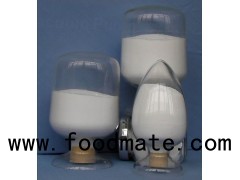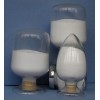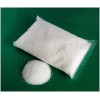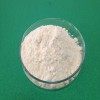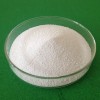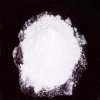CAS NO.: 108174-48-7
Molecular Formula: C121H200N42O39
Molecular Weight: 2867.14
Molar Mass: 2888.16
Peptide purity: > 98.0%
Appearance: White lyophilized powder
Related substance: Total Impurities (%) ≤ 2.0%
Acetate content: ≤ 15.0%
Bacterial Endotoxins: ≤5 IU/mg
Sequence: H-Tyr-Gln-Pro-Pro-Ser-Thr-Asn-Lys-Asn-Thr-Lys-Ser-Gln-Arg-Arg-Lys-Gly-Ser-Thr-Phe-Glu-Glu-His-Lys-NH2
Source: Chemical Synthesis
Reconstitution: To follow best practice guidelines for reconstituting PEG-MGF, reconstitute in sterile, bacteriostatic, distilled water, with light sonication if necessary.
Storage for PEG-MGF: Vials are freeze-dried and therefore will remain stable at room temperature for 1-2 months. However, for long term storage they should be kept a 2-8 degrees Celsius (refrigerator temperature), where they will remain stable for up to 18 months in powder form. Once mixed with mixing solution, vials should be stored in the refrigerator and not left at room temperature.
Shelf life: One year from dispatch.
PEG-MGF Application:
Mechano Factor (MGF), also known as IGF-1Ec, is a growth factor/repair factor that is derived from exercised or damaged muscle tissue. MGF has the ability to cause wasted tissue to grow and improve itself by activating muscle stem cells and increasing the regulation of protein synthesis, this unique ability can rapidly improve recovery and speed up muscle growth. MGF can initiate muscle satellite (stem) cell activation in addition to its IGF-I receptor domain which then in turn increases protein synthesis turnover, and therefore can if used correctly improve muscle mass over time.
However, MGF only lasts for about 5 - 7 minutes before it breaks down in the blood stream. Due to such a short half life, MGF is not widely used. Then, an additive Polyethylene Glycol (PEG) is added to the MGF, making it to be PEG-MGF. PEG acts as a protective coat and it will allow the MGF to be carried through the blood stream without being break down and give MGF a half life of several days.
PEG MGF is a splice variant of the i. produced by a frame shift if the i. gene and PEGylated to improve stability. PEG-MGF, or PEGylated Mechano gh, is a new and innovative form of the i. produced by a frame shift if the i. gene, namely Mechano gh (MGF), which is PEGylated to improve stability that outperforms natural MGF many times over. MGF is a splice variant of the i. gene which increases stem cell count in the muscle and allows for muscle fibers to fuse and mature. This is a process required for growth of adult muscle. Natural MGF is made locally and does not travel into the bloodstream. Synthetic MGF is water based and when administered intramuscularly, travels into the bloodstream. MGF is only stable in the blood stream for only a few minutes. Research has shown that PEG-MGF helps increase the muscle stem cell count, so that more may fuse and become part of adult muscle cells.
PEGylation is the act of attaching a Polyethylene glycol (PEG) structure to another larger molecule (in this case, MGF). The PEG acts as a protective coating and the theory here is that this will allow the MGF to be carried through the blood stream without being broken down. Neurological research has shown that utilizing PEGylated MGF resulted in a longer more stable acting version of the MGF peptide in serum/blood.
Mechano gh (MGF) exhibits local effects in skeletal muscle and without cannot travel through the body without modification. The problem with synthetic Mechano gh (MGF) is that it is introduced intramuscularly and is water based so it goes into the blood stream. When used this way, Mechano gh (MGF) only remains stable in the blood stream for a few minutes. Biologically produced MGF is made locally and does not enter the bloodstream. It is also short acting so stability is not an issue. By PEGylating the Mechano gh (MGF) it is almost as efficient as local produced Mechano gh (MGF) when used intramuscularly. This is accomplished by surrounding part of the peptide with a structure of polyethylene glycol, which can be attached to a protein molecule. The polyethylene glycol groups protect the peptide but do not surround it completely. The active sites of the peptide are still free to do their biological function. In this case the shell is a negative charged shield against positively charged compounds that would affect the protein.
PEG-MGF 2MG Application
Pegylated Mechano Growth Factor is a Research Peptide Hormone Mechano Growth Factor adds pegylation process to amino acid peptides synthesis is an original interlaced variant of IGF-1 (Insulin Like Growth Factor-I). MGF is a splice variant of the IGF gene which increases stem cell count in the muscle and allows for muscle fibers to fuse and mature. This is a process required for growth of adult muscle. Natural MGF is made locally and does not travel into the bloodstream. Synthetic MGF is water based and when administered intramuscularly, travels into the bloodstream. MGF is only stable in the blood stream for only a few minutes. PEGylation is the act of attaching a Polyethylene glycol (PEG) structure to another larger molecule (in this case, MGF). The PEG acts as a protective coating and the theory here is that this will allow the MGF to be carried through the blood stream without being broken down.


